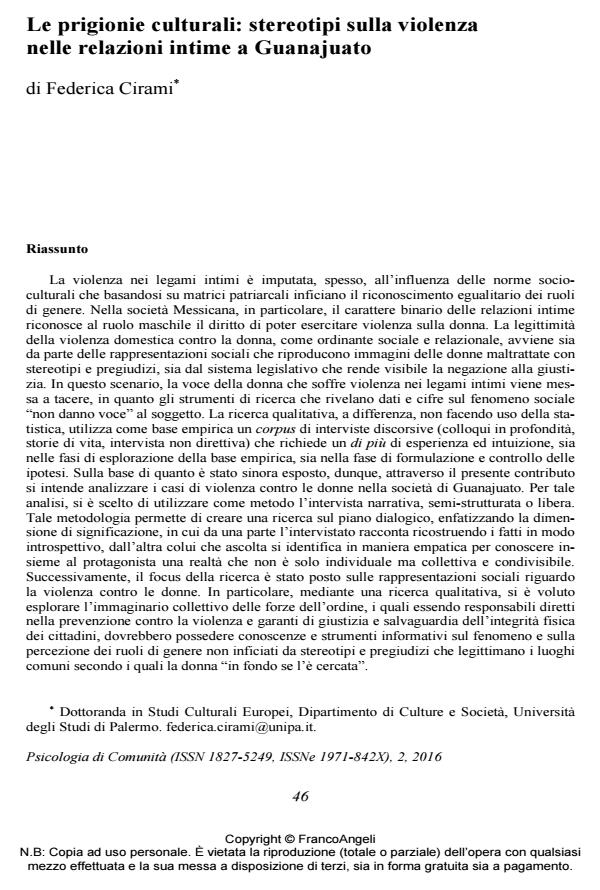Cultural Captivity: Stereotypes on Intimate Partner Violence in Guanajuato
Journal title PSICOLOGIA DI COMUNITA’
Author/s Federica Cirami
Publishing Year 2017 Issue 2016/2 Language Italian
Pages 11 P. 46-56 File size 150 KB
DOI 10.3280/PSC2016-002005
DOI is like a bar code for intellectual property: to have more infomation
click here
Below, you can see the article first page
If you want to buy this article in PDF format, you can do it, following the instructions to buy download credits

FrancoAngeli is member of Publishers International Linking Association, Inc (PILA), a not-for-profit association which run the CrossRef service enabling links to and from online scholarly content.
Intimate Partner Violence is allocated, often, to the influence of socio-cultural norms based on patriarchal matrix that disrupt the recognition of egalitarian gender roles. In Mexican society, in particular, the binary nature of intimate relationships recognizes to the male role the right to exercise violence against women. The legitimacy of domestic violence against women, such as social and relational regulator, takes place both by the social representations that reproduce images of battered women with stereotypes and prejudices, and the legislative system that makes visible the denial state of justice. In this scenario, the voice of the woman who has suffered violence in intimate relationships is silenced, thus researches that reveal data on the social phenomenon "do not give voice" to the subject. Unlike qualitative research, avoiding statistics, uses as empirical basis a corpus of conversational interviews (in-depth interviews, life stories, non-directive interview) that require more experience and intuition, both in stages of exploration of the empirical basis and in the formulation and monitoring of the hypotheses. Therefore, on the basis of what has been exposed through this contribution there will be analyzed the cases of violence against women in Guanajuato society. For this analysis, it has been chosen the method of narrative semi-structured or free interview. This methodology allows to create a search on the dialogical plan, emphasizing the dimension of signification, in which on the one hand the interviewee tells reconstructing the facts in the introspective way, and on the other the listener identifies with empathic way to learn along with the main character a reality that it is not only individual but collective and shareable. Successively, the research focuses on the analysis of social representations about violence against women. In particular, by conducting qualitative research, it will be explored the collective imagination of the police officers. In fact, they are directly responsible for the prevention against violence and guarantors of justice and the physical integrity and safeguard of citizens, and consequently they should possess knowledge and informational tools both on this phenomenon and on the perception of gender roles uninfluenced by stereotypes and prejudices that justify the stereotypes according to the principle "woman deserves it", because "she was asking for it".
Keywords: Intimate partner violence, Mexico, gender stereotypes, social representations of IPV, biographic interview, sexism
Jel codes: I12, J12
- Foucault M. (1976a). Storia della sessualità 1, La volontà di sapere. Milano: Feltrinelli, 1978.
- Foucault M. (1976b). Storia della sessualità 3. La cura di sé. Milano: Feltrinelli, 2001.
- Allport G.W. (1954). La natura del pregiudizio. Firenze: La Nuova Italia, 1973.
- Arcuri L., Cadinu M.R. (1998). Gli stereotipi. Dinamiche psicologiche e contesto delle relazioni sociali. Bologna: il Mulino.
- Atkinson R. (2002). L’intervista Narrativa. Raccontare la storia di sé nella ricerca formativa, organizzativa e sociale. Milano: Raffaello Cortina.
- Boca S., Bocchiaro P., Scaffidi Abbate C. (2003). Introduzione alla psicologia sociale. Bologna: il Mulino.
- Bourdieu P. (1998). Il dominio maschile. Milano: Feltrinelli, 2009.
- Butler J. (1997). La vita psichica del potere. Teorie della soggettivazione e dell’assoggettamento. Roma: Meltemi, 2005.
- Butler J. (2009). Frames of War. When is Life Grievable?. London, New York: Verso, testo disponibile al sito: http://humanities.wisc.edu /assets/misc/Butler.pdf
- Cirami F. (2014a). Gender Violence: Social Structure in Latin America, the question of victim and trauma. The International Journal of Humanities and Cultural Studies, 1: 1-15. DOI: 10.4399/978885487323013
- Cirami F. (2014b). La forza politicizzante del dolore: le resilient communities in Messico. Elephant & Castle, vol. 10: 5-30.
- El Colegío de México (COLMEX). (2010). Los Grandes Problemas Nacionales. Securidad nacional y securidad interior. Testo disponibile al sito: www.colmex.mx
- Gelli B. (2009). Psicologia della differenza di genere. Soggettività femminili tra vecchi pregiudizi e nuova cultura. Milano: FrancoAngeli.
- Hall S. (1980). Encoding/decoding. Culture, media, language: Working Papers in Cultural Studies. London: Hutchinson, pp. 128-138.
- Hall S., ed. (1997). Representation. Cultural Representations and Signifying Practices. London: Sage.
- Jung C.G. (1934-54). Gli Archetipi dell’Inconscio Collettivo. Torino: Bollati Boringhieri, 2012.
- Instituto Nacional de Estadistíca y Geografía (ENDIREH) (2006). Panorama de Violencia contra las mujeres. Testo disponibile al sito: http: file:///C:/Users/ Asus/Downloads/ENDIREH_Gto%20(1).pdf
- Ibid. (2011). Panorama de Violencia contra las mujeres. --Testo disponibile al sito: http://www3.inegi.org.mx/sistemas/biblioteca/detalle.aspx?c = 33229&upc = 702825051266&s = est&tg = 98&f = 2&pf = EncH&ef = 00&cl = 0
- Lagarde M. (2011). Los cautiverios de las mujeres: Madresposas, monjas, putas, presas y locas. Madrid: Horay HORAS Editorial.
- Lippmann W. (1922). L’opinione pubblica. Roma: Donzelli, 1998.
- Moscovici S. (1961-76). La Psychoanalyse; son image et son public. Paris: Presses Universitaires de France.
- Moscovici S., Farr M.R., a cura di (1984). Rappresentazioni sociali. Bologna: il Mulino, 2003.
- Paz O. (1950). The labyrinth of Solitude. New York: Grove Press, 1961.
- Petrillo G., Di Matteo C. (2007). In fondo se l’è cercata. Psicologia Contemporanea, 199: 6-11.
- Stainton-Rogers W., Stainton-Rogers R. (2011). The Psychology of Gender and Sexuality. New York: McGraw-Hill.
Federica Cirami, Le prigionie culturali: stereotipi sulla violenza nelle relazioni intime a Guanajuato in "PSICOLOGIA DI COMUNITA’" 2/2016, pp 46-56, DOI: 10.3280/PSC2016-002005